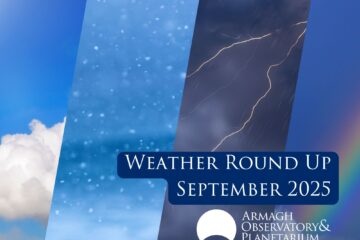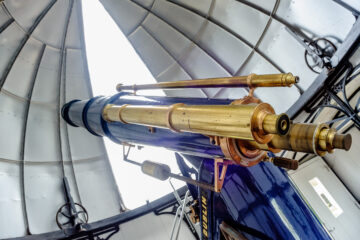JANUARY DRIER, COOLER, AND SUNNIER THAN AVERAGE
Armagh Observatory reports that January 2025 was drier, cooler, and sunnier than average. There were three named storms this month, bringing the total number of such storms to have affected Northern Ireland to a greater or lesser degree this 2024/2025 storm season to seven.
Total precipitation was 43.7 mm (1.72 inches) including 6 trace values, that is, 43.4 mm if trace values are ignored. This is approximately 60% of both the 183-year long-term (1838-2020) average January precipitation at Armagh (72.8 mm) and the most recent (1991-2020) 30-year average (72.7 mm). The wettest day was the 23rd, with 14.8 mm of precipitation associated with the arrival of Storm Eowyn. This had been named by the Royal Netherlands Meteorological Institute (KNMI) after a noblewoman of Rohan in the Lord of the Rings trilogy. Storm Eowyn, the fifth of the 2024/2025 storm season, caused power cuts and substantial damage including the loss of thousands of trees across Northern Ireland the following day.
The second and third wettest days were the 26th and 27th, with 9.1 mm and 7.1 mm of precipitation respectively. These wet days were associated with Storm Herminia, which had been named by the Spanish Meteorological Service (AEMET) and which brought severe weather to southern England and parts of France and Spain but not Northern Ireland. A further storm, namely Ivo, affected parts of southern England and the English Channel on the 29th but again missed Northern Ireland. This storm was named by the Portuguese Weather Service (IPEA).
Snowflakes were seen on the 2nd, with further snow on the night of the 6th/7th, leading to light snow cover approximately 1 cm deep that persisted for two days, melting on the morning of the 9th. A further dusting of snow, covering less than half the ground, was observed in the wake of Storm Eowyn on the morning of the 25th.
Storms Eowyn and Herminia brought exceptionally low atmospheric pressures to Northern Ireland. A value of 969.6 mbar reduced to mean sea level was recorded during Storm Eowyn at the time of observations (09:00 GMT) on the 24th. This 09:00 GMT low pressure was followed by 965.9 mbar at 09:00 GMT on the 27th associated with Storm Herminia. This was the sixth lowest January 09:00 GMT barometric pressure at Armagh since at least 1850 and the lowest such pressure at Armagh for 35 years, that is, since 961.9 mbar was observed at 09:00 GMT on 25 January 1990.
Storm Eowyn was also associated with an unusually sudden drop in atmospheric pressure. Whereas the 09:00 GMT reading was 969.6 mbar reduced to mean sea level, a few hours earlier the Automatic Weather Station had recorded a minimum of 956.7 mbar. This cannot be compared with Armagh’s long-term 09:00 GMT pressure series, but it probably represents one of the lowest January atmospheric pressures at Armagh for at least the last 175 years.
Another measure of the intensity of the exceptional Storm Eowyn is the width of the sharp drop in atmospheric pressure. According to the Automatic Weather Station, the pressure reduced to mean sea level was 978.9 mbar six hours before the minimum (956.7 mbar) and 978.8 mbar six hours later, implying a drop of more than 20 mbar in less than six hours.
A large flock of redwings was seen flying southwest on the morning of the 11th, and rooks were seen mobbing a buzzard on the 19th and on the 23rd chasing off two kestrels. A crowd of approximately 40 herring gulls was seen swirling above the meteorological station around the time of observations on the 19th, and again, though slightly fewer in number, on the 22nd.
The average temperature this January, namely 4.6 Celsius (40.28 Fahrenheit), was 0.4 C warmer than the 225-year long-term (1796-2020) average January temperature at Armagh (4.2 C) but 0.4 C cooler than the most recent (1991-2020) 30-year average (5.0 C). This was the coolest January at Armagh for four years, that is, since January 2021 (3.1 C).
The highest maximum air temperature, usually the warmest day, was 12.9 C on the 13th, followed by 12.6 C on the 14th, and 12.0 C on the 20th. The lowest maximum temperature, usually the coolest day, was -1.0 C attributed to the 8th. This was followed by 1.7 C attributed to the 4th, and then by 3.4 C on the 5th.
The highest minimum air temperature, usually the warmest night, was 9.6 C on the 14th. The lowest minimum air temperature, or coolest night, was -5.3 C on the 10th, followed by -4.7 C attributed to the 11th, and -4.2 C on the 8th.
This month there were 12 days with minimum air temperatures less than or equal to zero and 23 with ground frost. The coldest of these were -9.9 C on the 8th, followed by -9.6 C on the 10th, and -9.3 C on the 9th. There was just one day with a reported maximum air temperature less than or equal to zero, namely -1.0 C attributed to the 8th.
With 69.0 hours of strong sunshine, slightly sunnier than January 2024, this was the sunniest January at Armagh for 14 years, that is, since January 2011 (71.8 hours), and the eighth sunniest January at Armagh on record. January 2025 was approximately 49% sunnier than the 140-year long-term (1881-2020) January average at Armagh (46.2 hours) and 46% sunnier than the most recent (1991-2020) 30-year average (47.4 hours). The sunniest day was the 31st with 6.9 hours of strong sunshine, followed by the 6.4 hours on the 15th and 5.5 hours on the 29th.
These data refer to observations at Armagh Observatory, which has been recording the weather at Armagh since 1795.
For further information, please contact:
Professor Mark E. Bailey
Emeritus Director of Armagh Observatory
Armagh Observatory and Planetarium
College Hill
Armagh
BT61 9DG
Tel: 028-3752-2928
E-mail: mark.bailey@armagh.ac.uk



0 Comments